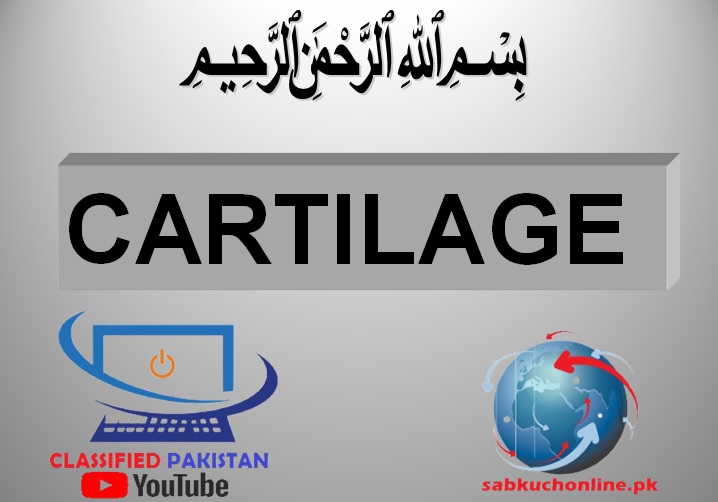Learning Objectives
•Enlist the components of cartilage
•Describe the characteristic features of each type of cartilage
•Describe the types and sequence of events in cartilage growth
•Differentiate among all the types of cartilage.

Perichondrium
•Divided into two layers
Outer fibrous : Of collagen fibers and fibroblasts and blood vessels
Inner cellular : In which are present Chondrogenic cells and chondroblasts

Cartilage Matrix
•Provides the rigidity, elasticity, & resilience
•Contain high concentration of bound sulfate so stains with basic dyes.

Cartilage Matrix
1.Chondroblasts
2.Chondrocytes
3.Collagen and in some cases elastin fibers
4.Glycosaminoglycans
5.Proteoglycans
6.Rich in water(70-80%)
GROUND SUBSTANCE

GROUND SUBSTANCE

Glycoproteins
•5% of the matrix
•Chondronectin and chondrocalcin
•Bind the chondrocytes to the extracellular matrix
Factors of tensile strength
•Collagen provides tensile strength and durability, however
•Proteoglycans are also important, e.g. if you inject papain (an enzyme that digests the protein cores of proteoglycans) into the ears of a rabbit, after a few hours the ears will loose their stiffness and droop
Cartilage Cells
1.Chondroblasts
2.Chondrocytes
Chondroblast
•Progenitor of chondrocytes
•Lines border between perichondrium and matrix
•Secretes type II collagen and other ECM components

Chondroblasts
•Derived from two sources: mesenchymal cells and chondrogenic cells of the inner cellular layer of the perichondrium. Chondroblasts are basophilic cells and Electron micrographs of these cells demonstrate a rich network of RER, a well-developed Golgi complex, numerous mitochondria, and an abundance of secretory vesicles.
Chondrocytes
•Mature cartilage cells , embedded in rigid extracellular matrix
•Reside in small spaces within the matrix that are called lacunae

•Those near the periphery are ovoid, whereas those deeper in the cartilage are more rounded
•A large nucleus with a prominent nucleolus
•Cytoplasm with many mitochondria, an elaborate RER, a well-developed Golgi apparatus Arranged in groups of 2 to 4


Chondrocytes
•Produce and maintain extra cellular matrix
•Either single or in isogenous groups
•Fat droplets, glycogen granules are found in cytoplasm.
•Active ones are more basophilic.


HISTOGENESIS OF CARTILAGE

CARTILAGE GROWTH
•Interstitial
–Increasing in LENGTH
–Mitotic division of preexisting chrondrocytes
–Chondrocytes divide and secrete matrix from within lacunae
–Occurs during early stages of cartilage formation and in articular cartilage
•Appositional
–Increasing in WIDTH
–Differentiation of chondrogenic cells ® chondroblasts
–Chondroblasts deposit matrix on surface of pre-existing cartilage
–Increase in girth

Interstitial growth

Interstitial growth

Appositional growth
A layer of chondroblasts can lay down matrix at the outer edge of a of growing cartilage.

Cartilages of the Human Body


TYPES OF CARTILAGE
1.HYALINE
2.ELASTIC
3.FIBROUS
HYALINE CARTILAGE



•Strong, rubbery, flexible

Matrix


Hyaline Cartilage. (H.P). H&E stain.

Hyaline Cartilage

Repair of hyaline cartilage
•Can tolerate considerable amount of stress
•Limited ability to repair Because of
1. Immobility of Chondrocytes
2. Less ability of Chondrocytes to proliferate
3. Avascularity
4. When hyaline cartilage calcifies it is replaced by bone
ELASTIC CARTILAGE
•Similar to hyaline cartilage but has abundant elastic fibers running in all directions
•Collagen type II

•Found in auricle of ear, walls of external auditory canals, eustachian tubes, epiglottis, larynx
•Maintains shape, deforms but returns to shape; flexibility of organ; strengths and supports structures.

•Elastic material gives the cartilage elastic properties
•Also resilience and pliability (hyaline cartilage)
•Matrix of elastic cartilage does not calcify during the aging process
•Main cell types à Chondroblasts & Chondrocytes

ELASTIC CARTILAGE ELASTIN STAIN

Elastic Cartilage


FIBROCARTILAGE
•A combination of hyaline cartilage & dense CT Chondrocytes may lie singly or in pairs, but most often they form short rows between dense bundles of collagen type I fibres.

Fibrocartilage
•Is typically found in relation to joints labrum, menisci, intervertebral disks, symphysis pubis
•Frequently found in the insertion of tendons

Fibrocartilage
•It is difficult to identify the perichondrium because of the fibrous appearance of the cartilage and the gradual transition to surrounding tissue types.

FIBROCARTILAGE
•Chondrocytes align between collagen fibers
•Collagen fibers lie parallel to lines of stress

Note the rows of Chondrocytes are separated by collagen fibers.



Functions of Cartilage Tissue
•It allows the tissue to bear mechanical stresses without permanent distortion
•Supports soft tissues.
•Smooth surface allows sliding against it.
•Essential for growth, development of bone.

